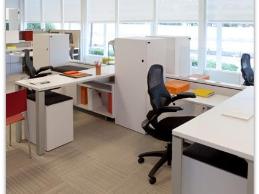From the desk of Linda Carter Batiste, J.D., Director of Services and Publications
With telework on the rise, some employers are downsizing their workspace and moving to shared workspaces without assigned workstations. Before taking this step, employers should consider the needs of employees who require workstation accommodations such as ergonomic design, alternative lighting, minimal distractions, fragrance-free environments, etc. Employers should approach accommodations on a case-by-case basis, but when considering shared workspace, it may be possible to build in flexibility to make shared workspace more accessible for employees with disabilities and ease the implementation of accommodations when necessary. Here are some things to consider when setting up or renting shared workstations:
Furniture and Equipment
- Universal design
- Adjustable, ergonomic chairs and desks
- Adjustable, ergonomic keyboards and mice
- Adjustable height monitor risers
- Accessible digital technology
Lighting
- Task lighting
- Alternative lighting
- Lighting gel filters
- Full spectrum or natural lighting
- Sun boxes and lights
- Simulated skylights and windows
- Window coverings
Distractions
-
Auditory
- Sound absorption and soundproof panels
- Sound masking systems
- Noise abatement
- Earplugs
- Dual headsets
- Noise canceling headsets or earbuds
- White noise machines
- Quiet work zones
-
Visual
- Desk facing away from office traffic and windows
- Work area away from office traffic
- Window coverings
- Private workspace
Temperature and Ventilation
- Personal air conditioners and heaters
- Redirection of ventilation
- Strategically placed air purifiers
Body Odor
- Use of a personal attendant
- Flexible breaks
- Private work area
- Work area closer to restroom
- Air purification
- Odor-absorbing products
Privacy
- Private space for employees to take medication or make medical calls
- Cubicle walls (1/2 or full)
- Cubicle doors and shields
Food, Fragrances, and Other Triggers
- Restricted use of foods and products that can trigger symptoms such as headaches and allergic reactions
- Fragrance policy or fragrance-free work area
- Kitchen/bathroom located away from work area
- Alternative cleaning materials
Problems Coping with Change
- Open communication related to what part of the workplace employees can make choices about and how problems, changes, and other requests will be handled
- Conduct rules related to personal habits that can be controlled
Effective Communication
- Multiple methods of communication, including email, one on one discussion, meetings, telephone, and instant messaging
- Point person for problems associated with move to shared workstations


